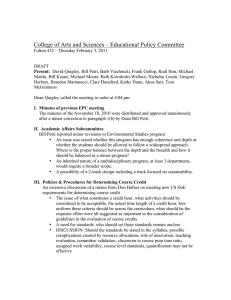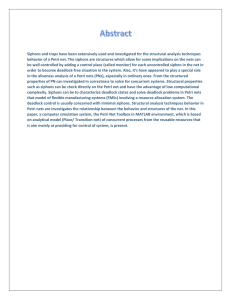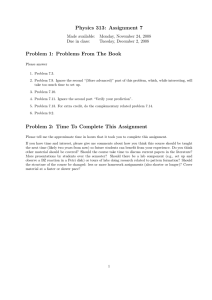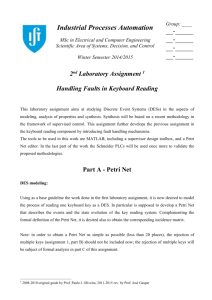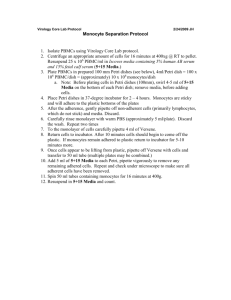www.ijecs.in International Journal Of Engineering And Computer Science ISSN:2319-7242
advertisement
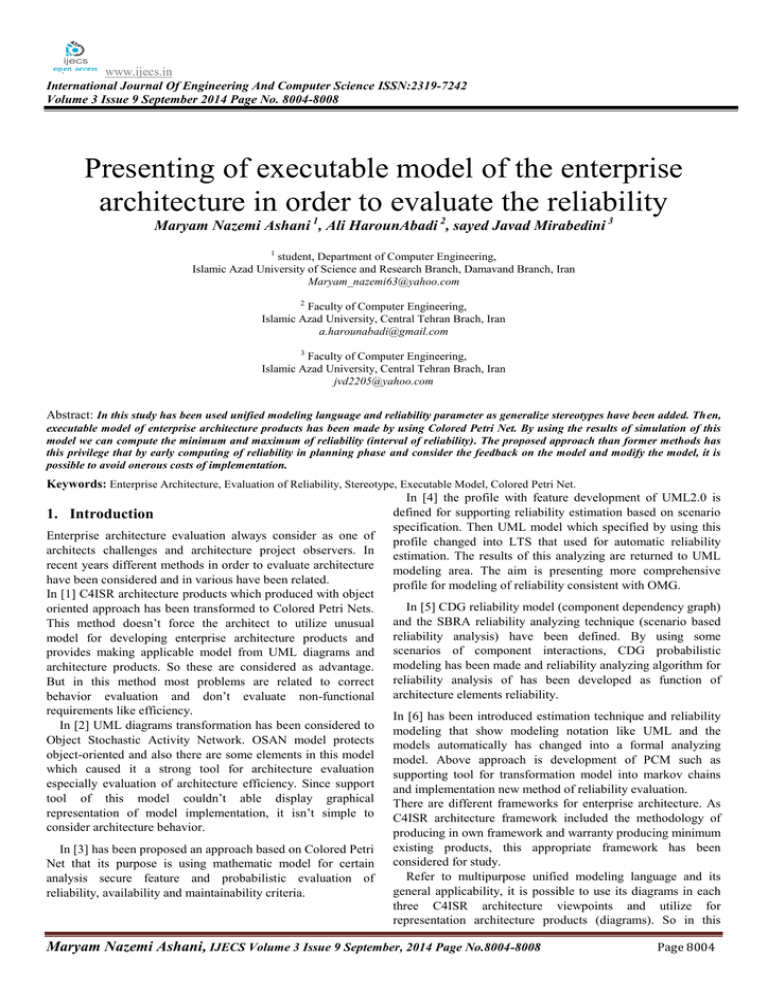
www.ijecs.in International Journal Of Engineering And Computer Science ISSN:2319-7242 Volume 3 Issue 9 September 2014 Page No. 8004-8008 Presenting of executable model of the enterprise architecture in order to evaluate the reliability Maryam Nazemi Ashani 1, Ali HarounAbadi 2, sayed Javad Mirabedini 3 1 student, Department of Computer Engineering, Islamic Azad University of Science and Research Branch, Damavand Branch, Iran Maryam_nazemi63@yahoo.com 2 Faculty of Computer Engineering, Islamic Azad University, Central Tehran Brach, Iran a.harounabadi@gmail.com 3 Faculty of Computer Engineering, Islamic Azad University, Central Tehran Brach, Iran jvd2205@yahoo.com Abstract: In this study has been used unified modeling language and reliability parameter as generalize stereotypes have been added. Then, executable model of enterprise architecture products has been made by using Colored Petri Net. By using the results of simulation of this model we can compute the minimum and maximum of reliability (interval of reliability). The proposed approach than former methods has this privilege that by early computing of reliability in planning phase and consider the feedback on the model and modify the model, it is possible to avoid onerous costs of implementation. Keywords: Enterprise Architecture, Evaluation of Reliability, Stereotype, Executable Model, Colored Petri Net. In [4] the profile with feature development of UML2.0 is defined for supporting reliability estimation based on scenario 1. Introduction specification. Then UML model which specified by using this Enterprise architecture evaluation always consider as one of profile changed into LTS that used for automatic reliability architects challenges and architecture project observers. In estimation. The results of this analyzing are returned to UML recent years different methods in order to evaluate architecture modeling area. The aim is presenting more comprehensive have been considered and in various have been related. profile for modeling of reliability consistent with OMG. In [1] C4ISR architecture products which produced with object In [5] CDG reliability model (component dependency graph) oriented approach has been transformed to Colored Petri Nets. This method doesn’t force the architect to utilize unusual and the SBRA reliability analyzing technique (scenario based model for developing enterprise architecture products and reliability analysis) have been defined. By using some provides making applicable model from UML diagrams and scenarios of component interactions, CDG probabilistic architecture products. So these are considered as advantage. modeling has been made and reliability analyzing algorithm for But in this method most problems are related to correct reliability analysis of has been developed as function of behavior evaluation and don’t evaluate non-functional architecture elements reliability. requirements like efficiency. In [6] has been introduced estimation technique and reliability In [2] UML diagrams transformation has been considered to modeling that show modeling notation like UML and the Object Stochastic Activity Network. OSAN model protects models automatically has changed into a formal analyzing object-oriented and also there are some elements in this model model. Above approach is development of PCM such as which caused it a strong tool for architecture evaluation supporting tool for transformation model into markov chains especially evaluation of architecture efficiency. Since support and implementation new method of reliability evaluation. tool of this model couldn’t able display graphical There are different frameworks for enterprise architecture. As representation of model implementation, it isn’t simple to C4ISR architecture framework included the methodology of consider architecture behavior. producing in own framework and warranty producing minimum In [3] has been proposed an approach based on Colored Petri Net that its purpose is using mathematic model for certain analysis secure feature and probabilistic evaluation of reliability, availability and maintainability criteria. existing products, this appropriate framework has been considered for study. Refer to multipurpose unified modeling language and its general applicability, it is possible to use its diagrams in each three C4ISR architecture viewpoints and utilize for representation architecture products (diagrams). So in this Maryam Nazemi Ashani, IJECS Volume 3 Issue 9 September, 2014 Page No.8004-8008 Page 8004 paper has been UML for architecture documentation and also has been Timed Colored Petri Net in order to develop executable architecture model. Since the exact reliability calculation in complex enterprises is difficult, so in this paper a new method is presented to evaluate the reliability that can be computed minimum and maximum reliability values. So we obtained reliability interval that accurate reliability located in this interval for complex systems that are difficult to evaluate the exact reliability. 2. 2.1 Basic Concepts C4ISR Architecture Framework Issued document of C4ISR architecture framework by defense ministry specified four viewpoints of information architecture and defined the described products of each view. Four views are total view, operating architecture view, system architecture view and technical architecture view. Each viewpoint describes specific feature of architecture by using text, graphical or tabular products [1]. 2.2. Stereotypes of The Unified Modeling Language Unified Modeling Language (UML) now is the most important standard language in industrial in order to distinct, imagination and documentation of products (artifacts) of Software systems. Actually a stereotype is an added new element to Unified Modeling Language modeling elements that has similar structure with one of preexistent elements with this difference that may added some extra constraints or its image and interpretation has been changed[7]. In this paper, we have benefited from presented profile stereotypes by Cortellessa [8]. This profile is used to evaluate the reliability analysis of component-based applications. 2.3 2.4 Transformation Algorithm First step for creating executable model is transformation of annotated sequence diagram to Timed Colored Petri Net. In this study, we use proposed algorithm in [10] as follows: If each component in sequence diagram with stereotype REcomponent would be annotated, this diagram for estimation of reliability of each component changes into Petri Net in accordance to expression 1[11]. Sent messages to a component as change into Petri Net and send to receiver component, their failure probability also refer to their arcs expressions will transfer to an extra location. Figure 1 shows this type of diagram and its equivalent Petri Net. If each message in the diagram annotate with REconnector stereotype it means the lose probability is specified, refer to expression 2[11], the lose probability between two component change into Petri Net in accordance to figure 2. In this transmission, transition of each sent message, in addition of sending message, saves the lose probability in new location. = prob (failure Cij) = 1 – (1- ) bpij (1) = (1 - ) |interact (I, m, j)| (2) For accounting the average lose probability in each system we use expression 3[11]: = 1(3) Colored Petri Net Colored Petri Nets has introduced as a developed model of Petri Nets. In addition of places, transitions and tokens in this network present color, guard and expression. The data amount carries by token in these networks. Colored Petri Nets represent more accurate models of complex asynchronous processing systems. In this networks unlike Petri Nets, tokens are distinguishable since each tokens own features as color [9]. Colored Petri Net is an ordered 6 items as CPN = (P, T, C, I-, I+, M0) that: 1. P is a finite set and non-empty of places 2. T is a finite set and non-empty of transition 3. = 4. C is colored function that maps set T P to non-empty set. 5. I- and I+ are fore runner and back runner functions which have defined on P*T as I-(p, t) I+ (p, t): C (t) C (p) (p, t) C (p) 6. M0 is a function which defined on P and is description of first signing as per p belong to P we have M0 (p) C (p). One of concepts that should be considered in the qualitative feature of reliability evaluation is time issue. In Colored Petri Nets, time concepts by an element called whole clock are introduced. The amount which this clock chooses presents time of model. Figure1. Annotated sequence diagram with stereotype REcomponent and equivalent Petri Net [10] Figure2. Annotated sequence diagram with stereotype REconnector and equivalent Petri Net [10] 3. Proposed Method 3.1 Generalizing Stereotype We generalize REcomponent stereotype as: Maryam Nazemi Ashani, IJECS Volume 3 Issue 9 September, 2014 Page No.8004-8008 Page 8005 The tagged value of REcompfailprob will generalize as: REcompminfailprob, REcompmaxfailprob 3.2 Executable Model Based on Colored Petri Net First step: for transmission of sequence diagram to Colored Petri Net of algorithm that presented in former section. Second step: for tagged values REcompminfailprob and REcompmaxfailprob we consider two locations of MinFail and MaxFail which first one has minimum failure and there is maximum failure in another one. Figure 3 shows the annotated Sequence diagram with generalized stereotype and equivalent Petri nets. REcompminfailprob and REcompmaxfailprob to each sequence diagram components that linked to lifeline exception lifeline which show system user. Also annotated interaction between component with REconnector stereotype and REconnfailprob tag. Figur4.Annotated use case diagram of Fuel Smart Label System along with reliability parameters Figure3. An annotated Sequence diagram with generalized stereotype and equivalent Petri nets Third step: accounting amounts For accounting the failure probability average in system level we account and that first average is minimum failure prob and another one is maximum failure prob. so it is possible to count max reliability and min reliability of system. Figure5. Annotated deployment diagram of Fuel Smart Label System along with reliability parameters 4. Case Study The fuel smart label system [1] is not complex and developing architecture products with C4ISR framework is possible and also it has many usages in this situation so it is suitable. One of targets of this example is possibility of reliability evaluation in enterprise architecture level that related information of these needs will be added to diagrams by architect. In use case diagram of this system, has been considered a prob between each relation of user and use case that this prob shows use case execution by user. Figure 4 shows use case diagram fuel intelligent tag system with these stereotypes. As it is specified in this figure, for actor, the prob of each need use case of reliability evaluation has been determined. Deployment diagram is annotated with reliability parameters because the aspect of reliability of nodes and links between them to express. In fact, based on these annotations the probability of failure can be assigned to each interaction of sequence diagram. Figure 5 shows the annotated deployment diagram of Fuel Smart Label System with Reliability stereotypes. Sequence diagram describes relation pattern of samples. This diagram presents periods number of each component in busy situation and failure prob of each component in j scenario for reliability evaluation. In figure 6 annotated relation information of reliability to sequence diagram of this system. In this figure, annotated REcomponent along with REbp, Figur6.Annotated sequence diagram of Fuel Smart Label System along with reliability parameters Because in this system, only one use case diagram in reliability evaluation was considered important and this diagram has one sequence diagram, According to the procedure described in the previous section, the sequence diagram is transformed to timed colored Petri net model. Figure 7 shows developed model of them in CPN Tools. Maryam Nazemi Ashani, IJECS Volume 3 Issue 9 September, 2014 Page No.8004-8008 Page 8006 Figure9. Information on the computation Monitor of maximum reliability the after run the model 5. Conclusion Figure7. Developed model of Colored Petri Net What has been related in this study was new method for enterprise architecture reliability evaluation. Therefore we tried by using Colored Petri Nets, present an executable model of architecture products here by it could be possible to simulate designed architecture and check the quality before architecture execution and accomplish necessary actions to reform designed architecture products. For creation an executable model for reliability evaluation, we utilities stereotypes annotation and tags to sequence diagram. Then simulate architecture by running model in CPN Tools software and by using of monitors in CPN Tools software which are strong, determined minimum and maximum reliability. References Figure8. Information on the computation Monitor of minimum reliability the after run the model After describing way of making practicable model, it is time to count minimum and maximum amount of reliability in the system. Therefore we use facility called monitor in CPN Tools is simulation and also supervisor in Colored Petri Net running. So for to determine of minimum and maximum reliability for each on separately, a monitor will be determined that count by using former relations and save the results in file. Figures 8 and 9 show files that information of monitor after execution of the model in which is stored. [3] Pinna, B., Babykina, G., Brinzei, N., Petin, J.F., “Deterministic and Stochastic Dependability Analysis of Industrial Systems using Coloured Petri Nets Approach”, Annual Conference of the European Safety and Reliability Association, ESREL, Amsterdam: Netherlands, 2013. [4] Rodrigues, G.N., Rosenblum, D.S., Uchitel, S., “Reliability Prediction in Model-Driven Development”, 8th International Conference, Model 2005, Montego Bay, Jamaica, October 2-7, Vol 3713,pp.339-354, 2005. [5] Yacoub, S., Cukic, B., Ammer, H.H., “A Scenario-Based Reliability Analysis Approach for Component-Based [1] Wagenhals, L.W., Haidar, S., Levis, A.H., “Synthesizing Executable Models of Object Oriented Architectures”, Journal of Systems Engineering, Vol.6, No.4, pp.266300, 2003. [2] Abdollahi Azgomi, M., Kamandi, A., Movaghar, A., “Modelling and Evaluation of Software Systems with Object Stochastic Activity Network”, International Conference on Software Engineering Advances, pp.5864, 2004. Software”, IEEE Transactions on Reliability, Vol 53, NO 4, Doi: 0018-9529/04$20.00, 2004. [6] Brosch, F., Koziolek, H., Buhnova, B., Reussner, R., “Architecture-based Reliability Prediction with the Palladio Component Model”, IEEE Transactions on Software Engineering, Vol x, NO x, 2011. [7] Unified Modeling Language (UML), version 1.4. OMG Documentation. At http://www.omg.org/technology/documents/ formal/uml.htm. [8] Cortellessa, V., Pompei, A., “Toward a UML Profile for QoS: A Contribution in the Reliability Domain”, Proc.4th International Workshop on Software and Performance, New York, USA, pp.197- 206, ISBN 158113-673-0, 2004. [9] Kart, J., Lars, M.K., “Coloured Petri Nets”, Springer Verlag Berlin Heidelberg, Doi:10.1007/b95112, ISBN: 978- 3- 642- 00284-7, 2009. [10] Emadi, S., “Mapping Annotated Software Architecture Description to a Petri Net Notations for Reliability Evaluation”, 3rd International Conference on Software Maryam Nazemi Ashani, IJECS Volume 3 Issue 9 September, 2014 Page No.8004-8008 Page 8007 Technology and Engineering, Doi: 10.1115/1.859797, 2011. [11] Cortellessa, V., singh, H., Cukic, B., “Early Reliability Assessment of UML Based Software Models”, Proc.3rd International Workshop on Software Italy, ACM. ISBN 11-58113-5637, 2002. Maryam Nazemi Ashani, IJECS Volume 3 Issue 9 September, 2014 Page No.8004-8008 Page 8008
